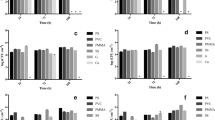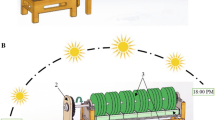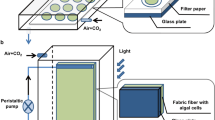Abstract
Microalgal biofilms can be a nuisance as surface foulants, especially in the marine environment; however, these biocoatings have practical application especially in biofilm cultivation systems to mitigate the limitations of microalgal suspension culture systems. Numerous works with regard to the modulation of extrinsic factors to study biofilm adhesion were found; however, they lack insight in the ubiquitous cell-substrate interactions which primarily govern cell adhesion in response to the surrounding environments. Thus, this work intended to shed light on the development of microalgal biofilm on four different pristine surfaces (plain drawing paper, polypropylene fabric, polyethylene plastic, and polyvinylidene fluoride flat sheet membrane) and to investigate the extent of microalgal substances resistance against disruption under liquid flow. The findings showed that algal biomass adhesion varied significantly with substratum type. The abundant hydrophilic polysaccharides extracted from Cylindrotheca fusiformis contributed the most to biofilm development for all substrata tested, while hydrophobic proteins analyzed from polypropylene fabric managed to retain biofilm structure though they are present in a much smaller amount. Extended Derjaguin, Landau, Verwey, and Overbeek (XDLVO) model revealed that the biofilm adhesion was mostly controlled by Lewis acid–base interactions (hydrophobic) in high ionic strength solution, while with the hydrokinetics present in the cultivation system showed the importance of pore size and surface roughness of substrata. It was demonstrated that materials with higher surface roughness and hydrophobicity, like plain drawing paper and polypropylene fabric, managed to provide a stronger biofilm attachment profile.








Similar content being viewed by others
Data availability
The datasets generated during and/or analyzed during the current study are available from the corresponding author on reasonable request.
References
Al-Amshawee S, Yunus MYBM, Lynam JG, Lee WH, Dai F, Dakhil IH (2020) Roughness and wettability of biofilm carriers: a systematic review. Environ Technol Innov 21:101233
Almond A (2005) Towards understanding the interaction between oligosaccharides and water molecules. Carbohydr Res 340:907–920
Balqadi AA, Salama AJ, Satheesh S (2018) Microfouling development on artificial substrates deployed in the central Red Sea. Oceanologia 60:219–231
Barranguet C, Veuger B, Van Beusekom SAM, Marvan P, Sinke JJ, Admiraal W (2005) Divergent composition of algal-bacterial biofilms developing under various external factors. Eur J Phycol 40:1–8
Bittar TB, Passow U, Hamaraty L, Bidle KD, Harvey EL (2018) An updated method for the calibration of transparent exopolymer particle measurements. Limnol Oceanogr Methods 16:621–628
Blanken W, Janssen M, Cuaresma M, Libor Z, Bhaiji T, Wijffels RH (2014) Biofilm growth of Chlorella sorokiniana in a rotating biological contactor based photobioreactor. Biotechnol Bioeng 111:2436–2445
Bos R, van der Mei HC, Busscher HJ (1999) Physico-chemistry of initial microbial adhesive interactions – its mechanisms and methods for study. FEMS Microbiol Rev 23:179–230
Cao F (2017) Hydrophobic features of extracellular polymeric substances (EPS) extracted from biofilms : an investigation based on DAX-8 resin technique. Doctoral dissertation, Université Paris-Est. https://tel.archives-ouvertes.fr/tel-01630489/file/TH2017PESC1048.pdf
Carroll T, King S, Gray S, Bolto B, Booker N (2000) The fouling of microfiltration membranes by NOM after coagulation treatment. Water Res 34:2861–2868
Cheng P, Wang Y, Liu T, Liu D (2017) Biofilm attached cultivation of Chlorella pyrenoidosa is a developed system for swine wastewater treatment and lipid production. Front Plant Sci 8:1594
Dalirian N, Abedini Najafabadi H, Movahedirad S (2021) Surface attached cultivation and filtration of microalgal biofilm in a ceramic substrate photobioreactaor. Algal Res 55:102239
Dubois M, Gilles KA, Hamilton JK, Rebers PA, Smith F (1956) Calorimetric method for determination of sugars and related substances. Anal Chem 28:350–356
Ekins-Coward T, Boodhoo KVK, Velasquez-Orta S, Caldwell G, Wallace A, Barton R, Flickinger MC (2019) A microalgae biocomposite-integrated spinning disk bioreactor (SDBR): toward a scalable engineering approach for bioprocess intensification in light-driven CO2 absorption applications. Ind Eng Chem Res 58:5936–5949
Flemming HC (2016) EPS-Then and now. Microorganisms 4:41
Flemming HC, Wingender J (2010) The biofilm matrix. Nat Rev Microbiol 8:623–633
Gao F, Yang ZH, Li C, Zeng GM, Ma DH, Zhou L (2015) A novel algal biofilm membrane photobioreactor for attached microalgae growth and nutrients removal from secondary effluent. Bioresour Technol 179:8–12
Gerlach R, Cunningham AB (2010) Influence of biofilms on porous media hydrodynamics. In: Vafai K (ed) Porous media: applications in biological systems and biotechnology. CRC Press, Boca Raton, pp 174–205
Govindan N, Maniam GP, Yusoff M, Ab Rahim MH, Chatsungnoen T, Ramaraj R, Chisti Y (2020) Statistical optimization of lipid production by the diatom Gyrosigma sp. grown in industrial wastewater. J Appl Phycol 32:375–387
Hart R, In-na P, Kapralov MV, Lee JGM, Caldwell GS (2021) Textile-based cyanobacteria biocomposites for potential environmental remediation applications. J Appl Phycol 33:1525–1540
Henderson RK, Baker A, Parsons SA, Jefferson B (2008) Characterisation of algogenic organic matter extracted from cyanobacteria, green algae and diatoms. Water Res 42:3435–3445
In-na P, Umar AA, Wallace AD, Flickinger MC, Caldwell GS, Lee JGM (2020) Loofah-based microalgae and cyanobacteria biocomposites for intensifying carbon dioxide capture. J CO2 Utilization 42:101348
Infante CD, Castillo F, Pérez V, Riquelme C (2018) Inhibition of Nitzschia ovalis biofilm settlement by a bacterial bioactive compound through alteration of EPS and epiphytic bacteria. Electron J Biotechnol 33:1–10
Ji C, Wang J, Zhang W, Liu J, Wang H, Gao L, Liu T (2013) An applicable nitrogen supply strategy for attached cultivation of Acutodesmus obliquus. J Appl Phycol 26:173–180
Johnson MB, Wen Z (2010) Development of an attached microalgal growth system for biofuel production. Appl Microbiol Biotechnol 85:525–534
Liu T, Wang J, Hu Q, Cheng P, Ji B, Liu J, Chen Y, Zhang W, Chen X, Chen L, Gao L, Ji C, Wang H (2013) Attached cultivation technology of microalgae for efficient biomass feedstock production. Bioresour Technol 127:216–222
Magaletti E, Urbani R, Sist P, Ferrari CR, Cicero AM (2004) Abundance and chemical characterization of extracellular carbohydrates released by the marine diatom Cylindrotheca fusiformis under N- and P-limitation. Eur J Phycol 39:133–142
Mahendran B, Lishman L, Liss S (2012) Structural, physicochemical and microbial properties of flocs and biofilms in integrated fixed-film activated sludge (IFFAS) systems. Water Res 46:5085–5101
Mantzorou A, Ververidis F (2019) Microalgal biofilms: a further step over current microalgal cultivation techniques. Sci Total Environ 651:3187–3201
Meng S, Liu Y (2016) New insights into transparent exopolymer particles (TEP) formation from precursor materials at various Na+/Ca2+ ratios. Sci Rep 6:19747
Moreno Osorio JH, Pinto G, Pollio A, Frunzo L, Lens PNL, Esposito G (2019) Start-up of a nutrient removal system using Scenedesmus vacuolatus and Chlorella vulgaris biofilms. Bioresour Bioprocess 6:27
Myklestad SM (1995) Release of extracellular products by phytoplankton with special emphasis on polysaccharides. Sci Total Environ 165:155–164
Naumann T, Çebi Z, Podola B, Melkonian M (2012) Growing microalgae as aquaculture feeds on twin-layers: a novel solid-state photobioreactor. J Appl Phycol 25:1413–1420
Orandi S, Lewis DM, Moheimani NR (2012) Biofilm establishment and heavy metal removal capacity of an indigenous mining algal-microbial consortium in a photo-rotating biological contactor. J Ind Microbiol Biotechnol 39:1321–1331
Ozkan A, Berberoglu H (2013) Adhesion of algal cells to surfaces. Biofouling 29:469–482
Passow U (2002) Transparent exopolymer particles (TEP) in aquatic environments. Prog Oceanogr 55:287–333
Perni S, Preedy EC, Prokopovich P (2014) Success and failure of colloidal approaches in adhesion of microorganisms to surfaces. Adv Colloid Interface Sci 206:265–274
Pierre G, Delattre C, Dubessay P, Jubeau S, Vialleix C, Cadoret JP, Probert I, Michaud P (2019) What is in store for EPS microalgae in the next decade? Molecules 24:4296
Podola B, Li T, Melkonian M (2017) Porous substrate bioreactors: a paradigm shift in microalgal biotechnology. Trends Biotechnol 35:121–132
Qu F, Liang H, He J, Ma J, Wang Z, Yu H, Li G (2012a) Characterization of dissolved extracellular organic matter (dEOM) and bound extracellular organic matter (bEOM) of Microcystis aeruginosa and their impacts on UF membrane fouling. Water Res 46:2881–2890
Qu F, Liang H, Wang Z, Wang H, Yu H, Li G (2012b) Ultrafiltration membrane fouling by extracellular organic matters (EOM) of Microcystis aeruginosa in stationary phase: influences of interfacial characteristics of foulants and fouling mechanisms. Water Res 46:1490–1500
Rincon SM, Romero HM, Aframehr WM, Beyenal H (2017) Biomass production in Chlorella vulgaris biofilm cultivated under mixotrophic growth conditions. Algal Res 26:153–160
Schnurr PJ, Allen DG (2015) Factors affecting algae biofilm growth and lipid production: a review. Renew Sustain Energ Rev 52:418–429
Sekar R, Venugopalan VP, Satpathy KK, Nair KVK, Rao VNR (2004) Laboratory studies on adhesion of microalgae to hard substrates. In: Ang PO (ed) Asian Pacific Phycology in the 21st Century: Prospects and Challenges. Kluwer, Dordrecht, pp 109–116
Seviour T, Yuan Z, van Loosdrecht MCM, Lin Y (2012) Aerobic sludge granulation: a tale of two polysaccharides? Water Res 46:4803–4813
Stadnyk I, Sabadosh G, Hushtan T, Yevchuk Y (2019) Formation of microbial biofilms on stainless steel with different surface roughness. Potr Slov J Food Sci 13:915–924
Tong CY, Derek CJC (2021) Biofilm formation of benthic diatoms on commercial polyvinylidene fluoride membrane. Algal Res 55:102260
Tong CY, Singh HKKL, Derek CJC (2021) Effect of high temperature toward microalgal organic matter and its impact toward membrane distillation application. Water Environ Res 93:1107–1115
van Loosdrecht MC, Norde W, Zehnder AJ (1990) Physical chemical description of bacterial adhesion. J Biomater Appl 5:91–106
Van Oss CJ (1994) Polar or lewis acid-base interactions. In: Interfacial forces in aqueous media. Marcel Dekker, New York, pp 18-46
Venable ME, Podbielski MR (2019) Impact of substrate material on algal biofilm biomass growth. Environ Sci Pollut Res Int 26:7256–7262
Villacorte LO, Kennedy MD, Amy GL, Schippers JC (2012) Measuring transparent exopolymer particles (TEP) as indicator of the (bio)fouling potential of RO feed water. Desal Water Treat 5:207–212
Xia L, Huang R, Li Y, Song S (2017) The effect of growth phase on the surface properties of three oleaginous microalgae (Botryococcus sp. FACGB-762, Chlorella sp. XJ-445 and Desmodesmus bijugatus XJ-231). PLoS One 12:e0186434
Xiao R, Zheng Y (2016) Overview of microalgal extracellular polymeric substances (EPS) and their applications. Biotechnol Adv 34:1225–1244
Yuan H, Wang Y, Lai Z, Zhang X, Jiang Z, Zhang X (2021) Analyzing microalgal biofilm structures formed under different light conditions by evaluating cell–cell interactions. J Colloid Interface Sci 583:563–570
Zeng X, Guo X, Su G, Danquah MK, Zhang S, Lu Y, Sun Y, Lin L (2015) Bioprocess considerations for microalgal-based wastewater treatment and biomass production. Renew Sustain Energ Rev 42:1385–1392
Zhang Q, Liu C, Li Y, Yu Z, Chen Z, Ye T, Wang X, Hu Z, Liu S, Xiao B, Jin S (2017) Cultivation of algal biofilm using different lignocellulosic materials as carriers. Biotechnol Biofuels 10:115
Zhang Q, Yu Z, Jin S, Liu C, Li Y, Guo D, Hu M, Ruan R, Liu Y (2020) Role of surface roughness in the algal short-term cell adhesion and long-term biofilm cultivation under dynamic flow condition. Algal Res 46:101787
Acknowledgements
This study was supported by the Trans-disciplinary Research Grant Scheme (TRGS) by the Ministry of Education (Grant No. 203/PJKIMIA/67612003). We also acknowledge Bu Kah Yee for his kind assistance in this experimental set up.
Author information
Authors and Affiliations
Corresponding author
Ethics declarations
Conflict of interest
The authors declare no competing interests.
Additional information
Publisher’s note
Springer Nature remains neutral with regard to jurisdictional claims in published maps and institutional affiliations.
Supplementary Information
Below is the link to the electronic supplementary material.
Rights and permissions
About this article
Cite this article
Tong, C.Y., Derek, C.J.C. The role of substrates towards marine diatom Cylindrotheca fusiformis adhesion and biofilm development. J Appl Phycol 33, 2845–2862 (2021). https://doi.org/10.1007/s10811-021-02504-1
Received:
Revised:
Accepted:
Published:
Issue Date:
DOI: https://doi.org/10.1007/s10811-021-02504-1




